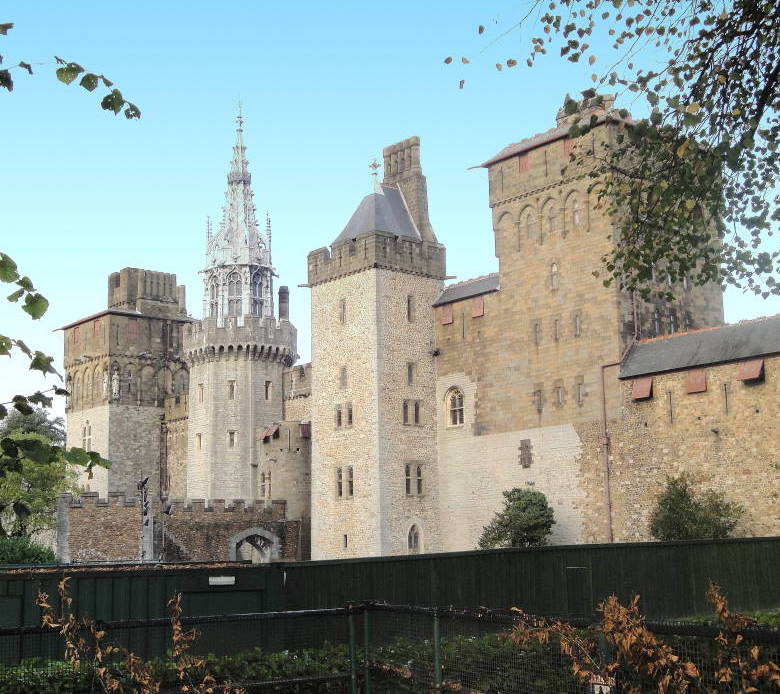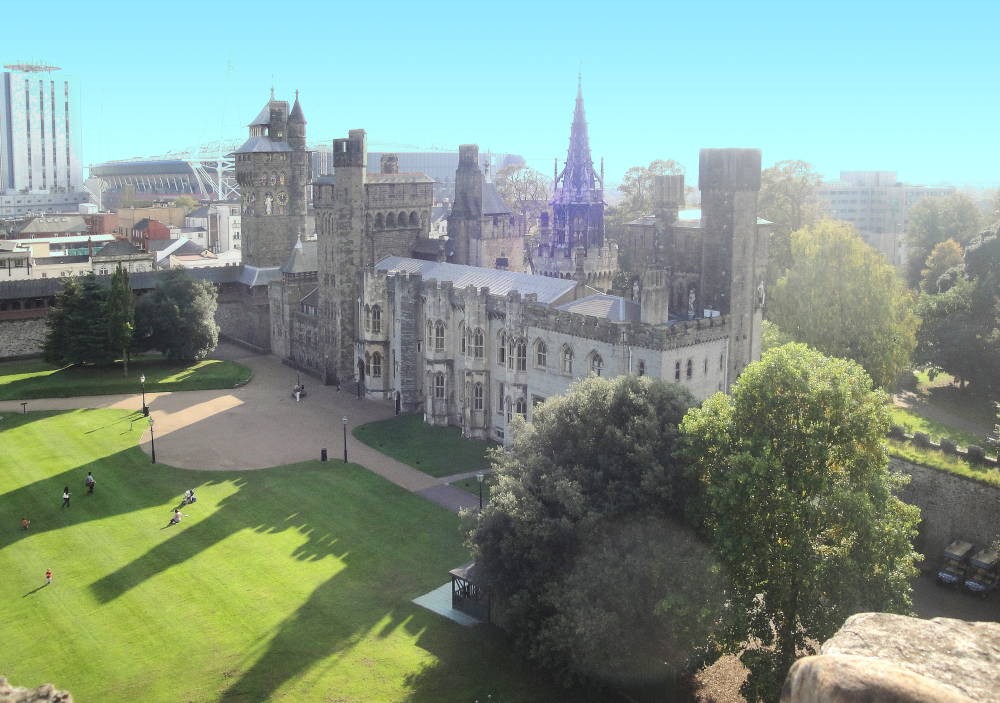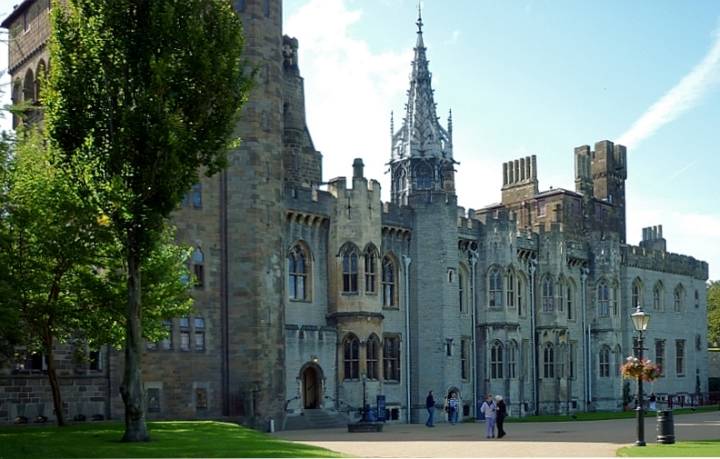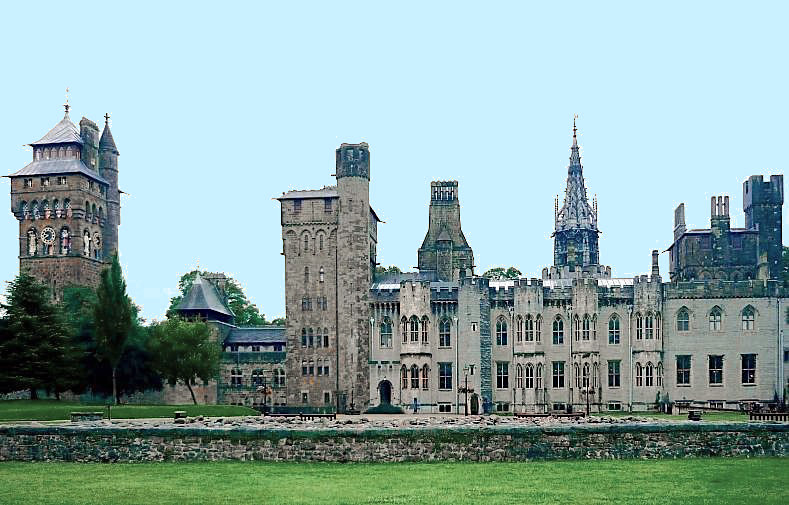Photographs by Jacqueline Banerjee and Robert Freidus. [Click on thumbnails for larger images. You may use these and the following images without prior permission for any scholarly or educational purpose as long as you (1) credit the photographer and (2) link your document to this URL.]

The rebuilding and redecoration of Cardiff Castle was William Burges's major life's work. He started planning it in 1865, the year he first met its owner, the young John Patrick Crichton-Stuart (1847-1900), the 3rd Marquess of Bute; he was still working on it when he died in 1881. The Bute family had helped to transform Cardiff into "the coal metropolis of the world" (Norwich 149) with a thriving port, and the Marquess was immensely wealthy. A Catholic convert like Pugin, he was as keen a medievalist as his architect. Burges was therefore given his head, and the requisite funding, to conjure a fabulous, richly Gothic stately home out of the old castle accommodation built on this historic site. He was by no means unique in taking on both the architecture and interior design of the building, but he was able to carry the twin project through to a splendidly dramatic High Victorian extreme.


Left to right: (a) The castle skyline from Bute Park. (b) Another view.


Left to right: (a) A view from above. (b) The West Tower.
The castle is best seen above the treetops in the adjoining Bute Park, where it brings to mind Milton's description of such a scene in "L'Allegro" — "Towers and battlements it [the eye] sees, / Bosomed high in tufted trees." It looks especially beautiful in autumn. The approach along Bute Park towards the Clock Tower is also spectacular.



Left to right: The Clock Tower from Castle Street. Close-up of (l. to r.) Mars and Sol on the Clock Tower. Mars and Sol, with Venus and Mercury on the next face of the Tower.
Built on the site of a Roman bastion, the Clock Tower in the south-west corner of the castle wall is perhaps the most attractive feature of the exterior. At over 130' high (some sources say 150'), it is certainly the most dominant. Nigel Jones describes it as "Architecturally, the most successful of the Burges work at Cardiff Castle" (51). As well as its colourful and gilded clock-faces and heraldry, it features the planets, named under the nine-foot-high figures as Mercury, Luna, Mars, Jupiter, Saturn, Venus, and Sol. Mars can be seen here with his shield, while Sol is holding a representation of the sun. Beside them on the left, on the next face of the tower, stand Venus and Mercury. The north face of the tower, not shown here, sports an oak tree motif from the arms of the Marquess.



Left to right: The old Norman keep. The castle from near the main entrance. A wide view of the castle and Clock Tower from nearer the Norman keep.
From inside the castle walls, the eye is first drawn to the compact old Norman keep on its impressively high motte. Burges, however, was concerned with the living quarters. Work began as soon as Bute came of age in 1868. Structurally, the previous residence here was transformed in two ways. Burges built "upwards in a series of extraordinary towers of differing shape and size, giving the castle an interestingly varied skyline" (Williams 9); and he adapted the interior arrangements as well, not only by building new rooms (the Clock Tower, for example, contains a whole suite of rooms) but also by tunnelling through the thick medieval walls to create passageways (see Jones 51), and opening up smaller rooms to make larger ones like the Banqueting Hall (see Williams 10, and Part II of this essay).




Left to right: The raised walkway along the castle wall towards the Clock Tower. Two different types of shutters in the stout castle wall, both seen from the inside of the walkway. A downspout in the form of a goat.
As for the larger elements of the rebuilding, such as the towers, and the overall effect, one of Burges's main influences both here and in Castell Coch was the French architect Viollet-le-Duc, who had reconstructed the Château de Pierrefonds and other medieval castles in France (see Curl 62 and especially McLees 21). But externally as well as internally, every little detail shows Burges's own thought and hand. On the outside this includes, for example, the different types of wooden shutters for the openings along the main castle wall, and animal heads on the drainage downspouts. Before so much as entering the castle, then, you are aware of a distinctive, not to say eccentric, mind at work. However, not even all the elaborate iconographic decoration on the Clock Tower can quite prepare you for what you find inside.
The Animal Wall along Bute Park



Left to right: A lioness, a pelican, and a vulture.



Left to right: Monkeys, an aardvark, and a seal or sea-lion.
The Animal Wall along the park approach once stood outside the castle itself, and is embellished by an assortment of stone animals, nine of them designed by Burges in typically humorous fashion, and carved after his death by Thomas Nicholls in 1891 (a further six, carved by Alexander Carrick, were added in 1931). Of those shown here, the lioness, sea-lion or seal, and pair of monkeys are by Nicholls, who also carved two separate lions each holding a shield, and a lynx, a bear, a wolf and a hyena. The others are by Carrick. The original carvings can be distinguished from the later ones by their amber-rimmed glass eyes, which sometimes strike passers-by as all too authentic!
Other Views of Cardiff Castle
- The Winter Smoking Room
- The Bachelor Bedroom and bathroom (in the Clock Tower)
- The Summer Smoking Room
- The Arab Room and Banqueting Hall
- The Library
- Lord Bute's Bedroom and Bath
- The Day Nursery
- The Roof Garden
Selected Bibliography
Crook, J. Mordaunt. "Burges, William (1827-1881)." Oxford Dictionary of National Biography. Online ed. Viewed August 2009.
Crook, J. Mordaunt.The Dilemma of Style: Architectural Ideas from the Picturesque to the Post-Modern. Chicago: University of Chicago Press, 1987.
Crook, J. Mordaunt.William Burgess and the High Victorian Dream. London: Murray, 1981.
Edwards, John. "Conserving Cardiff Castle." Journal of Architectural Conservation. Vol. 8 (1), 2002: 7-22.
Long, Helen. The Edwardian House: The Middle-Class Home in Britain, 1880-1914. Manchester: Manchester University Press, 1993.
McLees, David. Castell Coch. Cardiff: Cadw (Crown Copyright), rev. ed. 2005.
Marsh, Jan. William Morris & Red House: A Collaboration between Architect and Owner. London: Anova Books, 2005.
Muthesius, Stefan. The High Victorian Movement in Architecture, 1850-1870. London: Routledge, 1972.
Newman, John, et al. Glamorgan (Buildings of Wales, Vol. 3). New Haven: Yale University Press, 1995.
Norwich, John Julius, ed. Treasures of Britain: The Architectural, Cultural, Historical and Natural Heritage of Britain. Windsor: AA/Everyman, 2002.
Williams, Matthew. William Burges, 1827-81. Andover, Hants: Jarrold Publishing (Pitkin Guide), 2007.
Web Resources
"ST1876: Animal Wall — First Lion." Geograph (an Ordnance Survey sponsored site). Viewed 3 November 2009.
Last modified 28 November 2012